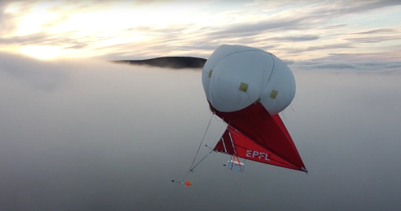
Helikite over Pallas, Finland, October 2022. Credit: Lionel Favre
Vertical properties of aerosols in the Arctic lower atmosphere and their impact on cloud radiative effects (VAERTICAL)
Funder: Swiss National Science Foundation
Duration: 1.11.2022 – 31.10.2026
Summary
The Arctic is warming two to three times faster than the global average with local and global consequences. However, not all drivers of the amplified warming are well understood. Aerosols have been identified as important contributors, albeit with significant remaining knowledge gaps and large uncertainties. Aerosols can originate from anthropogenic and natural sources, whereby the latter are likely changing due to climate change. Particles exert climate effects through their direct interaction with radiation and indirectly through cloud formation, and both processes depend strongly on the vertical distribution of aerosols. Aerosol-cloud interactions are especially uncertain owing to the paucity of observations and limited representation of ice/droplet processes in simulations of low-level mixed-phase Arctic clouds. Capturing the ratio of liquid droplets and ice crystals in these clouds is critical for the Arctic surface radiation budget, and the onset of springtime sea ice melt during warm and moist air mass intrusions (WAMIs). WAMIs may originate from regions with varying aerosol content and therefore the influence of co-advected aerosol on the optically thick mixed-phase clouds that form during these periods has to be investigated.
Considerable efforts to measure aerosol properties have been undertaken in the Arctic, however with the key caveat that most observations are ground-based. The Arctic lower atmosphere is strongly stratified due to the cold surface, meaning that surface data often do not represent the aerosols aloft, especially at cloud-forming levels. Aircraft-based observations and remote sensing alone cannot address this gap. With VAERTICAL we address this gap and motivate our research plan by the following three research questions:
- Under which conditions are ground-based observations representative of cloud-level aerosol populations?
- What are the sources of aerosols along vertical profiles in the lower atmosphere?
- What is the contribution of different aerosol sources to WAMI properties and their radiative effects?
To address the questions, VAERTICAL will operate a newly developed rugged tethered balloon system equipped with state-of-the-art aerosol, trace gas and meteorological instruments, reaching up to 800 m. Amongst other, we will investigate aerosol sources, cloud condensation nuclei and ice nucleating particles. We will use the data to constrain a numerical weather model to simulate cloud radiative properties associated with WAMIs. Field work will be carried out at Villum Research Station in northern Greenland with year-round sea ice presence, as well as from an icebreaker in the sea ice north of Svalbard, targeting springtime WAMIs. We focus on WAMIs as one particularly climate-relevant feature where vertical information on aerosol is important. Expected outcomes are:
- A significantly-enhanced knowledge of properties and origin of aerosols in the vertical, and their linkage to surface data in various thermodynamic boundary layer conditions.
- Understanding of the impact of co-advected aerosols on the radiative properties of WAMI clouds.
- A highly developed and tested tethered balloon system that encourages the community to conduct more research with such platforms to address key gaps in our field.
- Open access vertical aerosol data sets across the Arctic, which fill a critical information gap, and are particularly useful for the remote sensing and modeling communities to improve their tools.
Field campaigns
ARTofMELT spring 2023 – measurements of warm air mass intrusions north of Svalbard on icebreaker Oden.